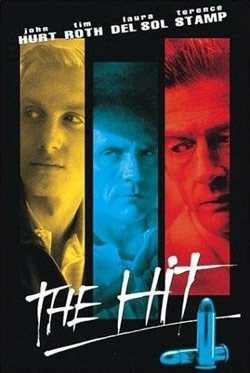 To grass, in British underworld parlance, means to inform on others to the police. According to the Oxford English Dictionary, it derives from the word “grasshopper,” Cockney rhyming slang for copper. The term has been around in Britain awhile, since the 1930's. In the 1970's, British journalists invented a new word, “supergrass,” to label an informer whose information implicates a large number of people involved in criminal activity. In London at the time, a number of mass trials saw supergrasses testify against former associates, gaining reduced sentences or outright immunity for themselves. Willie Parker, the Terence Stamp character in The Hit, released in 1984, is precisely this type of informer, and in an early scene in the film we see him standing in court, dressed in a suit, as he blithely turns state's evidence against a number of his old confederates. Seated in the dock as he details their crimes, they glare at him with murder in their eyes. When his testimony finishes, as he's led away by the court officers, the criminals break out together in song: “We'll all meet again. Don't know where, don't know when…” The viewer can’t help but chuckle (singing like this occurred at an actual London trial during the period), but we know that somebody from this pack of villains will be trying at a later date to even the score with Willie.
To grass, in British underworld parlance, means to inform on others to the police. According to the Oxford English Dictionary, it derives from the word “grasshopper,” Cockney rhyming slang for copper. The term has been around in Britain awhile, since the 1930's. In the 1970's, British journalists invented a new word, “supergrass,” to label an informer whose information implicates a large number of people involved in criminal activity. In London at the time, a number of mass trials saw supergrasses testify against former associates, gaining reduced sentences or outright immunity for themselves. Willie Parker, the Terence Stamp character in The Hit, released in 1984, is precisely this type of informer, and in an early scene in the film we see him standing in court, dressed in a suit, as he blithely turns state's evidence against a number of his old confederates. Seated in the dock as he details their crimes, they glare at him with murder in their eyes. When his testimony finishes, as he's led away by the court officers, the criminals break out together in song: “We'll all meet again. Don't know where, don't know when…” The viewer can’t help but chuckle (singing like this occurred at an actual London trial during the period), but we know that somebody from this pack of villains will be trying at a later date to even the score with Willie.
Cut to a flat, sunny landscape with bleach-white buildings, the southern coast of Spain. It's the Costa del Sol, or as the Brits call it, the Costa del Crime. Since the late 70’s, the area has been a popular haven for British criminals looking to escape pressure back home. In the welcoming Mediterranean climate, they settle in and live a comfortable life. Tensions between Spain and Britain over Gibraltar have resulted in lax extradition enforcement, and the criminals have traditionally blended in with the already large British expat community there. It’s the same region where Sexy Beast (2000) opens, with Ray Winstone’s retired English robber lounging poolside at his villa. But even if the authorities don’t come for you, people from your past life will. Just as the peace of Ray Winstone’s exile is destroyed by a former confederate determined to pull him back to London for another job, Terence Stamp’s Willie Parker can’t maintain his distance from his old world forever. Snatched from his book-lined home by four Spanish thugs, he winds up stuffed into a car with an older quiet professional killer named Braddock (John Hurt) and his young eager assistant Myron (Tim Roth).
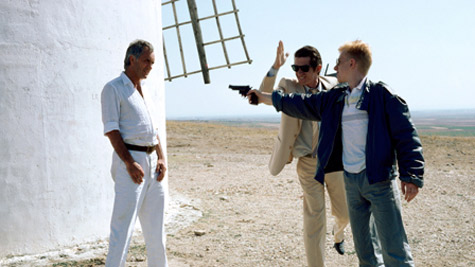
Their instructions are simple: drive Parker across Spain and over to Paris, France. The head mobster he betrayed years ago is now out of prison and living in Paris, and once they reach their destination, the boss will have Parker executed.
Few gangster films have a simpler plot than The Hit. Beyond the set-up I've described, the movie is virtually plotless. From the moment Parker is abducted and taken under the control of Braddock and Myron, The Hit unfolds as a road movie. The film spends a lot of time in the car with the three men—Braddock or Myron driving—and the Spanish countryside they cross is lovely. They make one stop at an apartment in Madrid; violence ensues; and they wind up adding a fourth member to their group, a sizzling young woman named Maggie (Laura del Sol) who in effect also becomes Braddock's and Myron's prisoner. The trip continues. And as it does, the tension the movie holds, the suspense it creates, develops from the characters' interplay. We observe their verbal thrusts and parries, their shifting moods in relation to each other, the conflicting desires and fears they exhibit.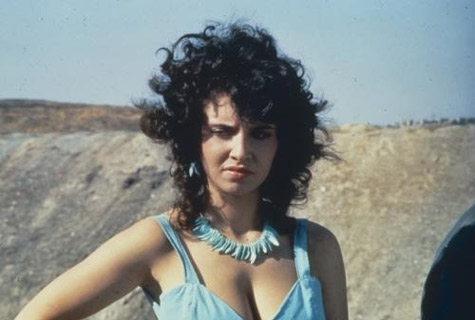
Or don't exhibit. From the moment Braddock and Myron grab him, Willie Parker displays no anxiety whatsoever about his imminent death, and he's the calmest, most agreeable prisoner possible. He chats about all manner of things with them—why he grassed, his decade in Spain, his take on life in general—and he obligingly serves as translator between the two of them and the Spanish woman. Through everything that happens, though certain he will die when they reach Paris, he displays a Zen-like tranquility that neither of his captors understands. He's clearly not a man who wants to die—he enjoys books and conversation and the majesty of waterfalls too much for that—but the prospect of dying is neither here nor there to him. He seems to be the embodiment of the Hemingway mantra “grace under pressure,” and indeed, there's no question that Ernest Hemingway's “The Killers” is the story that most comes to mind as a literary influence.
But in fact, both director Stephen Frears and screenwriter Peter Prince cite an Ambrose Bierce story as their main literary inspiration. The story is “Parker Adderson, Philosopher”, a Bierce Civil War tale about a Northern spy caught behind Confederate lines and sentenced to death. In the story, it's night and the spy assumes he'll be shot in the morning. Knowing when he'll be executed, he banters in a carefree, witty way with the General who'll command the firing squad. The spy makes jokes and expounds philosophical about the human propensity to fear death. The whole idea of fearing death makes no sense to him. Of course, the general is shocked at the man's attitude and questions him about his views. But this being an Ambrose Bierce tale, things twist at the end and don't resolve as one might expect. Similarly with The Hit, which hews closely to the Bierce tale right through to its final shot.
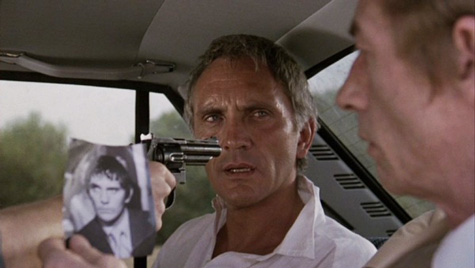
Parker as a character is fascinating, and Terence Stamp plays him with perfect meditative aplomb. Stamp had been a huge star of 1960's cinema, starring in the likes of Billy Budd, The Collector, Far from the Madding Crowd, and Poor Cow. Perhaps the crowning achievement of this phase of his career is his performance as the besotted English actor arriving in Rome to shoot a “Catholic western” in Federico Fellini's “Toby Dammit” segment of the horror film omnibus Spirits of the Dead (1968). By the end of the decade, however, he was less in demand for top tier roles, and after his girlfriend, the model Jean Shrimpton, left him, Stamp dropped out of mainstream films and moved to India. He lived and traveled there for 10 years and spent time at an ashram. Not until the late 70's did he return to big budget filmmaking, when he appeared in both Superman I and II as General Zod, and The Hit represented his first true starring role in a long time. Actor and character meld perfectly in Willie Parker, and it's not difficult to comprehend why. The arc of Stamp's life and the arc of Parker's have a lot in common. You buy Parker as a man of experience who has come to a point where he is at peace with himself and the world. Apparent peace, anyway. Because in all truth, convincing as Parker is when he says he doesn't fear dying, we can't be sure he's not playing mind games with his captors. He has a mischievous sense of humor he uses at intervals to poke Braddock and Myron, test them, and he says specific things to exacerbate tensions between the pair. Whether Parker's calm surface is, at least in part, a ruse to help him somehow escape his predicament is one of the questions you have about him as you watch the movie.
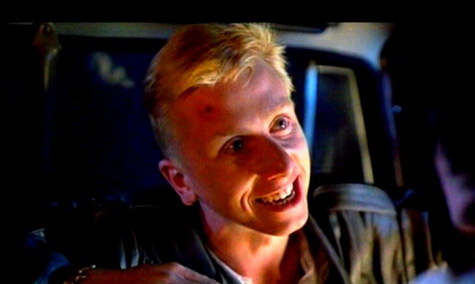 But it's not he alone who's mysterious. What makes The Hit work so well is that there are two characters in addition to Parker who have depth and mystery to them. Tim Roth had made his acting debut the year before playing a skinhead in Alan Clarke's Made in Britain, a TV film, and The Hit is his first theatrical movie. He's very good, but he hadn't yet developed the acting polish we see in his later performances. With no formal training to call on, he brings a raw energy to the role that suits his apprentice killer. Early in the film, he listens intently to his boss Braddock, seeming to hinge on every word the man says as if they are pearls of wisdom. This uncritical loyalty erodes as the film progresses, however, and you wonder if at any point, his volatility will expand into outright disobedience. He's also funny, though not because his character tries to be. Tim Roth says that he himself had never been out of Britain before doing the film, and the same must be true of Myron. Surrounded by the gorgeous landscape, he expresses distaste for Spain and makes it clear that he wants nothing more than to “get the fuck out of this country.” When he goes to an outdoor cafe to grab a few beers for his traveling companions, he takes instant offense at the gentle ribbing the Spanish patrons seem to be giving him, and then proceeds to attack them all, slashing them, butting them, pulling down the cafe's awning. He is pure British football hooligan, a force for destruction abroad, and back in the car, he sums it up by saying, “Oh Christ, that felt good.” Yet he softens as the film goes along, affected by Maggie's presence and even, at times, by discussions he has with the contemplative Parker. You don't know where Myron's character is going and whose side he will ultimately take. Will he turn against Braddock to help Maggie, or will he complete his part of the job and continue to assist Braddock?
But it's not he alone who's mysterious. What makes The Hit work so well is that there are two characters in addition to Parker who have depth and mystery to them. Tim Roth had made his acting debut the year before playing a skinhead in Alan Clarke's Made in Britain, a TV film, and The Hit is his first theatrical movie. He's very good, but he hadn't yet developed the acting polish we see in his later performances. With no formal training to call on, he brings a raw energy to the role that suits his apprentice killer. Early in the film, he listens intently to his boss Braddock, seeming to hinge on every word the man says as if they are pearls of wisdom. This uncritical loyalty erodes as the film progresses, however, and you wonder if at any point, his volatility will expand into outright disobedience. He's also funny, though not because his character tries to be. Tim Roth says that he himself had never been out of Britain before doing the film, and the same must be true of Myron. Surrounded by the gorgeous landscape, he expresses distaste for Spain and makes it clear that he wants nothing more than to “get the fuck out of this country.” When he goes to an outdoor cafe to grab a few beers for his traveling companions, he takes instant offense at the gentle ribbing the Spanish patrons seem to be giving him, and then proceeds to attack them all, slashing them, butting them, pulling down the cafe's awning. He is pure British football hooligan, a force for destruction abroad, and back in the car, he sums it up by saying, “Oh Christ, that felt good.” Yet he softens as the film goes along, affected by Maggie's presence and even, at times, by discussions he has with the contemplative Parker. You don't know where Myron's character is going and whose side he will ultimately take. Will he turn against Braddock to help Maggie, or will he complete his part of the job and continue to assist Braddock?
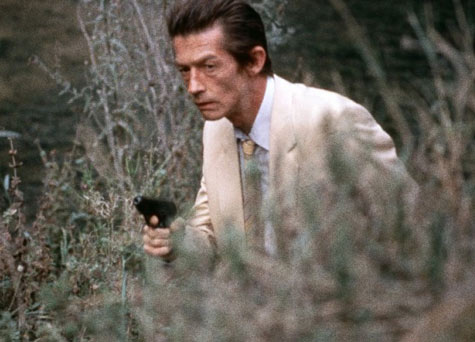 Most elusive of all is Braddock, an inscrutable killer if ever there was one. While Tim Roth bounces around the screen (appropriately for Myron), his shoulders rolling, elbows jutting, John Hurt moves with a fluid economy. He wastes no motion, yet carries threat and authority in his bearing. Myron loves to yammer and chat, Braddock talks little. It’s safe to say he doesn’t wear his emotions on his face, but Hurt is fantastic at showing just enough to let you know this is a world-weary man. He may be tired of his profession. He may have doubts, not so much about what he’s doing and the morality of it, but about where in life his profession has brought him. Still, he’s being paid for a job, and he’s not about to abandon it. He kills one man, off-screen, just to make sure the path they’re leaving behind them is clean, and we see him shoot a total stranger in the head at point-blank range—an execution. No question that he has the requisite ice water in his veins.
Most elusive of all is Braddock, an inscrutable killer if ever there was one. While Tim Roth bounces around the screen (appropriately for Myron), his shoulders rolling, elbows jutting, John Hurt moves with a fluid economy. He wastes no motion, yet carries threat and authority in his bearing. Myron loves to yammer and chat, Braddock talks little. It’s safe to say he doesn’t wear his emotions on his face, but Hurt is fantastic at showing just enough to let you know this is a world-weary man. He may be tired of his profession. He may have doubts, not so much about what he’s doing and the morality of it, but about where in life his profession has brought him. Still, he’s being paid for a job, and he’s not about to abandon it. He kills one man, off-screen, just to make sure the path they’re leaving behind them is clean, and we see him shoot a total stranger in the head at point-blank range—an execution. No question that he has the requisite ice water in his veins.
SPOILER Paragraph Begins*****
But when it comes time to shoot Maggie, quivering on the ground beneath him, he can’t do it. Is it a sudden burst of compassion he feels, or maybe even love? Of course, his most human act is also his weakest. But this entire motley crew—Parker, Myron, Braddock—has been doomed from the start, trailed during the length of their trip by the Spanish police. They’re not even aware the cops are closing in on them (the lead cop is Fernando Rey, aka Frog Number One in The French Connection), and so there’s a tinge of hopeless absurdity to their entire voyage. It’s one of the things that gives The Hit its singular quality. It’s a gangster film that’s a road movie about three unpredictable people headed to fates they never envision. Only Maggie will be unscathed, and her final actions bring a wisp of grace to the desperate Braddock. The killer’s expression as the movie ends suggests he’s the one, of all people, who’s accepted what Parker was talking about.
SPOILER Paragraph Ends*****
The Hit did poor business when it opened, though reviews were strong. For Stephen Frears, it represented a return to big screen cinema thirteen years after his directorial debut Gumshoe (1971). While Gumshoe, starring Albert Finney, is a private eye yarn of uncertain tone, semi-serious, semi-parody, The Hit mixes its humor and violence and thoughtfulness beautifully. Frears had been working for those thirteen years in British television, churning out dramas and comedies and TV movies on all sorts of topics, and the years honing his skills paid off. The camerawork in The Hit is crisp but unobtrusive, the pacing unhurried yet not slow. The soundtrack’s opening bars, guitar music by Eric Clapton, using a tune he claims Roger Waters gave him, pulls the viewer into the film at once, and the rest of the score, composed and played by flamenco guitarist Paco de Lucia, provides texture. Add the literate script by Peter Prince, the characters you just can’t pigeonhole, and you can see why the film has grown in stature since its release. People and their behavior have remained the focus of Frears’ work ever since, but luckily he’s never lost interest in criminal behavior. Twice more he’s returned to the crime film, adapting Jim Thompson’s The Grifters in 1990—the best Thompson adaptation to date—and making Dirty Pretty Things, a London-set film about illegal immigrants, in 2002. That’s one superb crime film every decade: I’ll take it. But of the three, the most unusual, the one least easy to grasp, is The Hit. It’s a film that stands up well to repeat viewings.
Scott Adlerberg lives in New York City. A film nut as well as a writer, he co-hosts the Word for Word Reel Talks film commentary series each summer at the HBO Bryant Park Summer Film Festival in Manhattan. He blogs about books, movies, and writing at Scott Adlerberg’s Mysterious Island. His Martinique-set crime novel, Spiders and Flies, is available now from Harvard Square editions at Amazon, B&N, and wherever books are sold.

Superb piece, Scott. You’ve given me a yen not only to watch the film but to read that Bierce story, as well. Nice work.
Thanks, Brian.
Excellent critique, learned a lot, thanks.